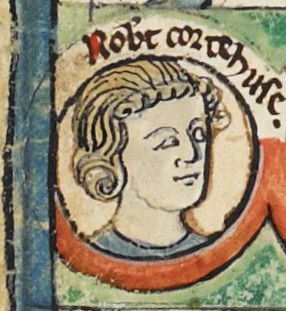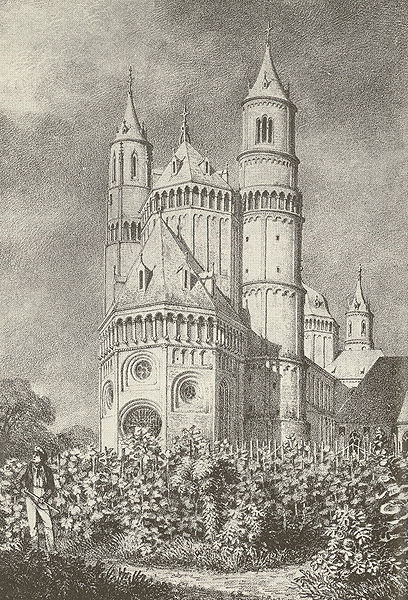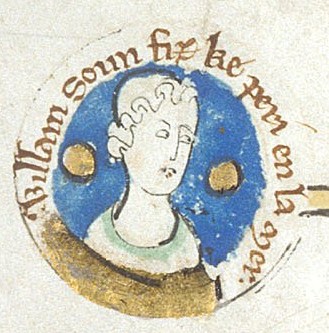 |
| Henry ! |
Contested Inheritances
Matilda[i] was the granddaughter of the Conqueror; her father Henry, being the youngest of William’s four sons. It is believed
that her father killed his older brother William Rufus to snatch the throne of England[ii]. Matilda, born on 7th
February 1102 at Sutton Courtenay in Berkshire[iii], was the eldest of Henry’s children
by his first wife Matilda of Scotland[iv].
In August
1103 Matilda’s brother William Adelin[v] was born. Henry, not a man to keep
his penis to himself, provided Matilda and William with at least twenty half-brothers
and sisters. Although a rather naïve and credulous William of Malmesbury states of Henry that;
‘Throughout his life he was
altogether free of lewd desires, for….he cast himself into the embraces of
women not for the gratification of carnal pleasures but to beget offspring, nor
did he assent to sexual intercourse except when it could bring about the
spreading of the royal seed. He was thus the master of his libido not its
servant.’[vi]
Matilda was
probably brought up at her mother’s court, where she would have met her Uncle David, King of Scotland, her half-brother Robert of Gloucester and other of the nobility. In 1108,
while he visited Normandy, Henry left Matilda in the care of the Archbishop of Canterbury Anselm[vii] one of Queen Matilda’s favoured
clerics.
 |
| Robert Curthose |
Henry’s feud
with his brother Robert Curthose was a re-occurring feature of his
reign; both men wanting what the other had. Henry attempted to seize Robert’s
domains during his absence on crusade. Upon his return Robert appealed to Pope Paschal II against Henry’s illegal seizure of the English throne after
William Rufus’ death. He approached the families who had supported Henry and
persuaded many of them to become turncoats.
Robert’s
invasion of England in 1101 ended with the Treaty of Alton. In return Henry allied himself with Robert’s enemies and
then won the battle of Tinchebrai[viii] in 1106. the king of France Louis VI[ix] recognised Henry’s control of
Normandy in 1106. But possession of the duchy was threatened in later years by
Henry’s nephew William Clito, King Louis and Fulk of Anjou[x].
A Pawn in the European Marriage Market
 |
| Henry V (L) |
Henry looked
for allies in his struggle with France using his children, legitimate and
illegitimate, as pawns in alliances with France’s enemies. In 1108 or early
1109, Henry V King of the Romans[xi], wrote to Queen Matilda suggesting
that he marry her six year old daughter, as well as sending envoys to her
husband in Normandy. Queen Matilda obviously acted on Henry V’s letter as he
wrote again thanking her for her efforts on his behalf.
Matilda’s
dowry was 100,000 marks[xii], a sum which even the
comparatively rich Anglo-Norman kingdom struggled to raise. Many of the great
religious houses claimed exemption from the tax to pay her dowry[xiii] At a great council at Nottingham on 17th October 1109 Matilda signed the royal
diploma creating the see of Ely; calling herself Mathildis
sponsa regis Romanorum. The final details of the deal were negotiated at Westminster in June 1109 and, as a result of her
changing status, Matilda attended a royal council for the first time that
October.
At the age
of eight, in late February 1110 Matilda was sent to Germany to live at her
future husband’s court; Henry was twenty four. Matilda arrived in Liège in early March where she first met her husband-to-be and they were
betrothed in Utrecht on 10th April. After the
betrothal she was placed into the custody of Bruno, the Archbishop
of Trier, who was
tasked with educating her in German culture, manners and government.
Henry
granted Matilda her dower, including lands in Utrecht; in later years she was to
make donations to a religious house in the area. Matilda was crowned Queen of
the Germans on 25th July 1110 in the cathedral of Mainz by Frederick Archbishop of Cologne, assisted by Bruno, Archbishop of
Trier and Henry’s counsellor.
A Coronation and a Wedding
William of Malmesbury
had little to say about Matilda herself[xiv], but went into great
detail of Henry V’s crowning as Holy Roman Emperor on 12th February
1111 following a successful invasion of Italy to force the Pope to do his duty
and crown the elected Emperor.
‘They led him, with litanies, to the confessionary of the Apostles, and
there the bishop of Ostia anointed him between the shoulders and on the right
arm. This being done he was conducted, by the sovereign pontiff, to the altar
of the aforesaid apostles, and there the crown being placed on his head by the
pope himself, he was consecrated emperor.’[xv]
 |
| Worms cathedral |
Following
the enthronement a rebellion in western Europe and Germany[xvi] blew up. Henry V had to
suppress the revolt before he and Matilda could marry. The wedding took place
on 7th January 1114, at the great cathedral in Worms when Matilda was twelve. The nobility and clergy were
present in great number;
‘So numerous were the
wedding gifts which various kings and primates sent to the emperor, and the
gifts which the emperor from his own store gave to the innumerable throngs of
jesters and jongleurs and people of all kinds that not one of his chamberlains
who received or distributed them could count them.’[xvii]
Matilda
acted impeccably throughout the marriage service; one chronicler remarking that
she was;
‘Distinguished and
beautiful, who was held to bring glory and honour, both to the Roman Empire and
the English realm.’[xviii]
Other Pawns
 |
| William Adelin |
In 1113 the
nine year old William Adelin was betrothed to Matilda, Fulk of Anjou’s daughter[xix]. The marriage was
intended to split Count Fulk off from his companions in arms. William of
Malmesbury reports that Fulk bestowed upon William Adelin the County of Maine
as Matilda’s dowry[xx];
‘His father-in-law bestowing
on him the county of Maine as her dower.’[xxi]
William of
Malmesbury informs us;
‘For to him [William
Adelin], when scarcely twelve years of age, all the free men of England and
Normandy, of every rank and condition, and under fealty to whatever lord, were
obliged to submit themselves by homage, and by oath.’[xxii]
In the same
year William Adelin’s half-sister Matilda was married to Conan III, Duke of Brittany. Another of Henry’s illegitimate daughters Sybilla[xxiii] was married to Alexander, King of the Scots, while Matilda Fitzroy was married to Rotrou III, Count of Perche. Alice Fitzroy was married to Matthieu I of Montmorency while another Matilda Fitzroy was made Abbess of Montvilliers. Numerous of Henry’s male bastards were given lands
and titles in their own right, strengthening Henry’s hold on the nobility.
Bibliography
The Feudal
Kingdom of England 1042-1216 – Frank Barlow, Pearson Education Ltd 1999
Stephen and
Matilda – Jim Bradbury, The History Press 2005
She-Wolves –
Helen Castor, Faber and Faber 2010
Early
Medieval England – MT Clanchy, Folio Society 1997
Henry I – C
Warren Hollister, Yale University Press, 2003
The
Plantagenets – Dan Jones, William Collins 2013
King Stephen
– Edmund King, Yale University Press 2010
Doomsday to
Magna Carta – AL Poole, Oxford University Press 1987
At the Edge
of the World – Simon Schama, BBC 2002
Early
Medieval England – Christopher Tyerman, Stackpole Books 1996
[i]
Also spelt as Maud
[ii]
The eldest Robert Curthose was made Duke of Normandy by
his father and died without heirs, leaving his brother Henry to inherit the
dukedom. Richard,
the second son died in a hunting accident in the New Forest. William Rufus
was gifted with the throne of England while Henry Beauclerk was left without
any inheritance. Rivalry between the brothers erupted when Robert and William
united to drive Henry out of the powerbase he had created for himself in the Cotentin.
[iv]
Also known as Edith; Matilda was the name she was given when christened. One of
Matilda’s attractions was her Anglo-Saxon royal blood
[v]
Or William the Aethling
[vi]
Henry I - Hollister
[vii]
Later Saint Anselm
[viii]
In Normandy
[ix]
Known as the Fat
[xii]
Which Henry V would use to fund his journey to Rome for his crowning as Holy
Roman Emperor by the Pope.
[xiv]
There is a paucity of information relating to Matilda’s early life
[xvi]
Over clerical questions thrown to the wolves in an agreement between Henry V
and Pope Paschal II
[xvii]
She–Wolves - Castor
[xviii]
Ibid
[xix]
Sixteen years later Matilda was married to Fulk’s son; an emphasis of just how
important the alliance with Fulk was to Henry.
[xxii]
Ibid
Lovely and clear concise summation of a period that is quite confusing at times [if not as much so as The Anarchy which followed]. Adelin is a double diminutive of Adam and a bit more upmarket than the more common diminutive of Adam, which was Adcock. I'll be using these posts to write one of the WIPs
ReplyDelete